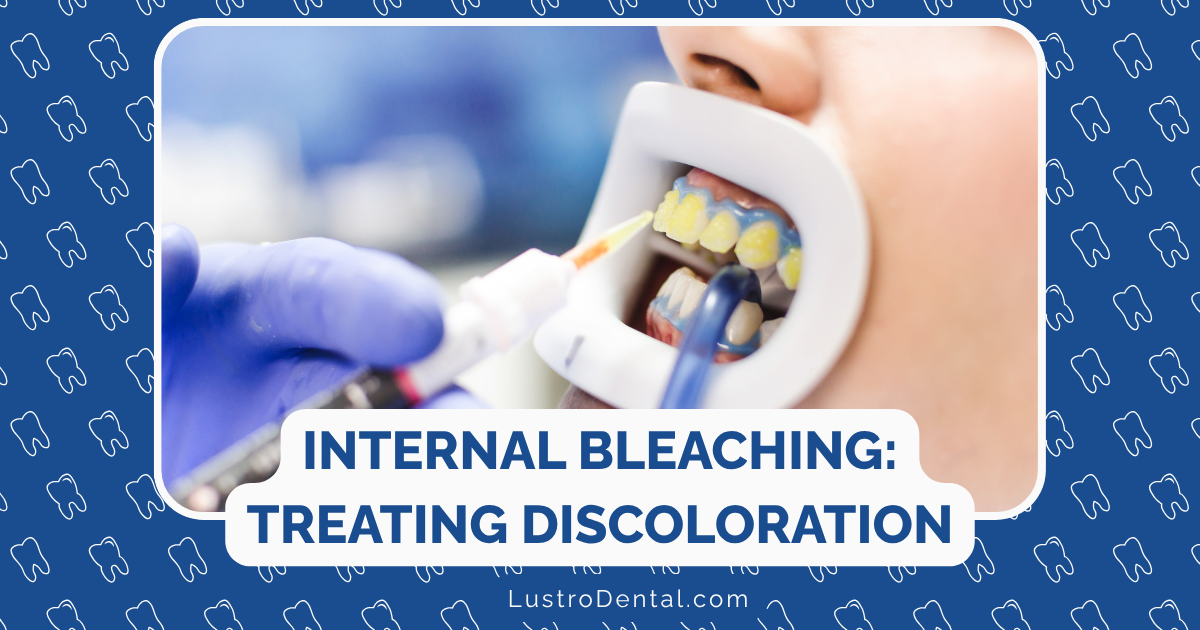Regenerative Endodontics: The Future of Keeping Teeth Alive After Infection

For decades, the standard approach to treating infected or necrotic dental pulp has been relatively straightforward: remove the damaged tissue, clean and shape the canal, and fill it with an inert material. While this traditional root canal therapy effectively eliminates infection, it leaves behind a technically “dead” tooth—one without the living pulp tissue that provides sensation, immune defense, and continued development in younger patients.
But what if there was another way? What if we could not just remove the infection but actually regenerate the living tissues that were lost?
This is the promise of regenerative endodontics, an exciting frontier that’s transforming how we approach pulp damage and offering new hope for maintaining truly vital teeth throughout our lives.
Beyond Traditional Root Canals: Understanding the Regenerative Revolution
Traditional root canal therapy has been remarkably successful at saving teeth that would otherwise require extraction. However, it comes with limitations. Teeth without vital pulp become more brittle over time, lose their ability to sense temperature changes, and in young patients with immature roots, may remain structurally compromised.
Regenerative endodontics takes a fundamentally different approach. Rather than simply removing damaged tissue and replacing it with synthetic materials, it aims to stimulate the body’s own healing mechanisms to regenerate the pulp-dentin complex.
Dr. Sonali Shah, endodontic researcher at the University of Pennsylvania School of Dental Medicine, explains: “We’re shifting from a paradigm of replacement to one of regeneration. Instead of asking ‘How can we fill this space?’ we’re asking ‘How can we help the body rebuild what was lost?'”
The Biology Behind Pulp Regeneration
To understand regenerative endodontics, we need to appreciate the remarkable healing potential of dental tissues. The tooth pulp contains a diverse population of cells, including:
- Dental pulp stem cells (DPSCs): Multipotent cells capable of differentiating into various cell types
- Stem cells from the apical papilla (SCAP): Highly proliferative stem cells found at the developing root tips
- Odontoblasts: Specialized cells that form dentin
- Fibroblasts: Cells that create the pulp’s structural framework
- Immune cells: Defenders against microbial invasion
- Vascular and neural cells: Providing blood supply and sensation
According to a 2024 review in the Journal of Cellular and Molecular Medicine, successful pulp regeneration requires three key elements working in harmony:
- Stem cells: Either resident cells recruited through cell homing or transplanted cells
- Scaffolds: Biocompatible structures that provide a framework for tissue growth
- Signaling molecules: Growth factors and other bioactive compounds that direct cell behavior
When these elements come together in the right environment, they can recreate the complex structure and function of the dental pulp.
Revascularization vs. Regeneration: Understanding the Terminology
The field of regenerative endodontics uses several terms that are important to distinguish:
- Revascularization: The reestablishment of blood supply to the root canal space
- Revitalization: The restoration of vitality to the tooth through tissue ingrowth
- Regeneration: The complete recreation of the original pulp-dentin complex
Dr. Martin Trope, a pioneer in the field, clarifies: “True regeneration means recreating the exact tissue that was lost, with all its components and functions. What we often achieve clinically is revitalization—the ingrowth of vital tissue that may not be identical to the original pulp but restores many of its functions.”
While complete regeneration remains the ultimate goal, even partial revitalization represents a significant advancement over conventional root canal treatment.
Current Clinical Approaches to Regenerative Endodontics
The Revitalization Protocol
The most widely used regenerative procedure today involves a protocol that has evolved significantly since its introduction in the early 2000s. According to the American Association of Endodontists (AAE), the current approach typically includes:
- Case selection: Usually young patients with immature teeth showing pulp necrosis
- Minimal instrumentation: Cleaning the canal with minimal mechanical disruption
- Chemical disinfection: Using irrigants like sodium hypochlorite at concentrations that balance effectiveness with cell viability
- Intracanal medication: Often using modified triple antibiotic paste or calcium hydroxide
- Blood clot formation: Intentionally inducing bleeding from the periapical tissues to create a natural scaffold
- Placement of a capping material: Typically mineral trioxide aggregate (MTA) or Biodentine
- Coronal seal: A durable restoration to prevent recontamination
This approach has shown promising results, particularly in immature permanent teeth, with success rates of 70-80% reported in terms of continued root development and restoration of some pulp vitality.
Outcome Measures: What Constitutes Success?
Regenerative endodontic procedures are evaluated based on several criteria:
- Primary goals: Resolution of symptoms and evidence of periapical healing
- Secondary goals: Increased root wall thickness and continued root length development
- Tertiary goals: Positive response to vitality testing, suggesting restoration of neural function
A 2023 systematic review published in the Journal of Endodontics found that while most cases achieve the primary goals, the secondary and tertiary outcomes show more variability. This highlights the need for continued refinement of techniques.
The Cutting Edge: Stem Cell-Based Approaches
While the current revitalization protocol relies on resident stem cells and the body’s natural healing capacity, the next generation of treatments involves direct stem cell therapy.
Types of Stem Cells Being Investigated
Several sources of stem cells show promise for endodontic regeneration:
- Dental pulp stem cells (DPSCs): Harvested from extracted teeth, particularly wisdom teeth
- Stem cells from the apical papilla (SCAP): Especially potent for regenerative purposes
- Bone marrow-derived mesenchymal stem cells (BMMSCs): More accessible but less specialized
- Umbilical cord mesenchymal stem cells (UCMSCs): Showing promising results in early clinical trials
- Induced pluripotent stem cells (iPSCs): Reprogrammed adult cells with embryonic-like potential
Autologous vs. Allogeneic Approaches
One of the most exciting developments came in early 2025, when RD Dental Clinic in Japan began the first clinical trial using allogeneic (donor-derived) dental pulp stem cells for pulp regeneration. This represents a significant advance because:
- Autologous (self-derived) treatments require the patient to have healthy teeth available for stem cell harvesting
- Approximately 80% of patients over age 45 lack suitable donor teeth for autologous treatment
- Allogeneic approaches could make regenerative treatments accessible to a much broader patient population
The Japanese trial aims to treat 10 patients with irreversible pulpitis or apical periodontitis, with results expected by late 2025.
Advanced Scaffolds and Delivery Systems
Beyond stem cells themselves, researchers are developing sophisticated scaffolds to support cell growth and differentiation:
Natural Scaffolds
- Platelet-rich fibrin (PRF): Derived from the patient’s own blood, providing both structural support and growth factors
- Collagen matrices: Mimicking the natural extracellular matrix of the pulp
- Chitosan-based materials: Derived from crustacean shells, offering antimicrobial properties
Synthetic and Hybrid Scaffolds
- Hydrogels: Three-dimensional networks that can be injected as liquids and solidify in place
- 3D-printed scaffolds: Custom-designed structures with precise architecture
- Nanofiber matrices: Electrospun materials that mimic the natural tissue environment
Dr. Sarah Chen, biomaterials researcher at Harvard School of Dental Medicine, notes: “The ideal scaffold isn’t just a passive structure—it actively participates in the regeneration process by releasing signals at the right time and place to guide cell behavior.”
Challenges and Limitations in Regenerative Endodontics
Despite its promise, regenerative endodontics faces several challenges:
Technical Challenges
- Disinfection vs. cell viability: Finding the balance between eliminating infection and preserving stem cell function
- Vascularization: Ensuring adequate blood supply throughout the regenerated tissue
- Innervation: Restoring the neural components of the pulp
Clinical Limitations
- Case selection: Current techniques work best in young patients with immature teeth
- Predictability: Results can vary significantly between patients
- Long-term stability: Limited data on the longevity of regenerated tissues
Practical Considerations
- Cost and accessibility: Advanced stem cell therapies remain expensive and limited to research centers
- Regulatory hurdles: Cell-based therapies face complex approval processes
- Training requirements: Practitioners need specialized skills to perform these techniques
The Patient Experience: What to Expect
For patients considering regenerative endodontic procedures, the experience differs from traditional root canal therapy in several ways:
Treatment Process
- Usually requires multiple appointments spaced over several weeks
- May involve harvesting cells from another site (in autologous approaches)
- Often less mechanical instrumentation but similar disinfection protocols
- May cause temporary discomfort when inducing bleeding for scaffold formation
Recovery and Aftercare
- Regular follow-up appointments to monitor progress
- Radiographic evaluation at 3, 6, 12, and 24 months
- Possible sensitivity as neural elements regenerate
- Potential for tooth discoloration (particularly with certain medicaments)
As one patient from a clinical trial shared: “The process took longer than a regular root canal, but knowing there was a chance my tooth could actually heal itself made it worth it. Six months later, tests showed my tooth was responding to cold again—something I was told would never happen after a traditional root canal.”
Who Can Benefit? Ideal Candidates for Regenerative Procedures
While regenerative approaches continue to evolve, current evidence suggests they are most successful in:
- Young patients (typically under 30) with immature permanent teeth
- Cases of pulp necrosis due to trauma or developmental anomalies
- Teeth with open apices (>1mm diameter)
- Patients without significant systemic health concerns
However, as techniques advance, these criteria are expanding. The recent Japanese clinical trial is specifically targeting adult patients with mature teeth suffering from irreversible pulpitis or apical periodontitis—conditions previously considered beyond the reach of regenerative approaches.
The Future Landscape: What’s on the Horizon
The field of regenerative endodontics is advancing rapidly, with several exciting developments on the horizon:
Emerging Technologies
- Bioprinting: Creating precisely designed pulp tissue constructs with 3D bioprinters
- Gene therapy: Delivering genetic material to enhance regenerative capacity
- Exosomes: Using cell-derived vesicles to deliver regenerative signals without the cells themselves
- Smart materials: Responsive scaffolds that adapt to the changing environment during healing
Integration with Other Fields
- AI-guided treatment planning: Using artificial intelligence to optimize protocols for individual patients
- Chairside stem cell processing: Simplifying cell-based therapies for everyday clinical use
- Immunomodulation: Controlling inflammation to enhance regenerative outcomes
According to Dr. Anthony Smith, Director of the Center for Dental Regeneration: “Within the next decade, I believe regenerative approaches will become the standard of care for many endodontic conditions. The question will shift from ‘Can we regenerate this pulp?’ to ‘Why would we not try to regenerate it?'”
Finding a Provider: Accessing Regenerative Endodontic Care
If you’re interested in regenerative endodontic options, consider these steps:
- Consult with an endodontist: Specialists in root canal therapy are most likely to offer regenerative procedures
- Ask about experience: Look for providers who have specific training in regenerative techniques
- Consider academic centers: University dental schools often lead in implementing new approaches
- Explore clinical trials: Visit ClinicalTrials.gov and search for “regenerative endodontics” to find active studies
Conclusion: A Paradigm Shift in Dental Care
Regenerative endodontics represents more than just a new treatment technique—it embodies a fundamental shift in how we think about dental disease and healing. Rather than simply managing damage, we’re learning to harness and enhance the body’s natural regenerative capacity.
While challenges remain and many approaches are still evolving, the progress in this field offers hope that in the future, a diagnosis of pulp necrosis won’t necessarily mean the end of a tooth’s vitality. Instead, it could mark the beginning of a regenerative journey, resulting in a tooth that continues to function, develop, and maintain its natural defenses.
As we continue to refine these techniques and expand their applications, regenerative endodontics promises to transform our approach to dental care, preserving not just the structure of teeth but their full, living vitality for years to come.







